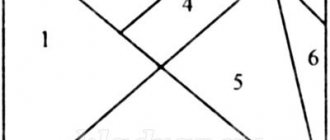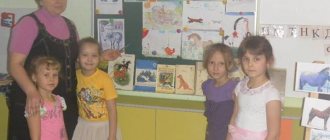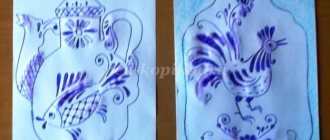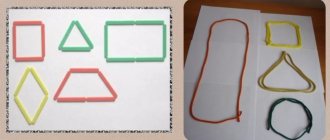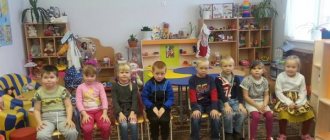Summary of a lesson on familiarization with fiction in the senior group of kindergarten
Summary of educational activities for familiarization with fiction using the technology of productive reading in the senior group.
N. Nosov “Lollipop”. Author: Bykova Natalya Ivanovna, teacher of the Children's Educational Institution "Child Development Center - Kindergarten No. 110", Petrozavodsk Republic of Karelia Description of the material: The lesson notes were developed for children of the senior group, addressed to preschool teachers. The lesson uses productive reading and listening technology, which ensures children’s full perception and understanding of the text. Topic: Reading N. Nosov’s story “Lollipop”. Goal: To promote the assimilation of moral standards of behavior in children through familiarization with N. Nosov’s story “Lollipop”. Educational areas: social and communicative development, cognitive development, speech development, artistic and aesthetic development, physical development. Objectives: 1) Social and communicative development. Develop communication and interaction of the child with adults and peers. To cultivate moral ideas in children (truthfulness, honesty), to develop the ability to think and evaluate the actions of literary heroes. 2) Cognitive development. Continue to introduce children to the works of children's writer N. Nosov. Create a desire (motivation) to read a work of fiction. Develop curiosity, imagination and creativity. 3) Speech development. Develop coherent, grammatically correct dialogical and monologue speech. Enrich your active vocabulary. 4) Artistic and aesthetic development. Cultivate interest in works of fiction. 5) Physical development. Develop movement coordination. Material: portrait of N. Nosov, book by N. Nosov with the work “Lollipop”.
Move
1. Motivational stage. The teacher draws the children's attention to the new book. Educator: Guys, today I was given this wonderful book by Nikolai Nosov for our library. Are you familiar with this writer? What story have you already read? (“The Living Hat”) Who was this story about? (A story about two friends and a kitten on whom a hat fell from the chest of drawers. The boys at first thought that the hat had come to life and were very scared. But they soon found out why the hat was moving). Is the story “The Living Hat” funny or sad? (funny, cheerful) Educator: One of the stories in N. Nosov’s new book is called “Lollipop.” Do you know what a lollipop is? (A lollipop is a transparent candy made from a frozen mixture of sugar with water or fruit juice. Often attached to a stick). What is another name for candy? (candy, caramel) Guys, I just can’t tell what kind of story this is in terms of mood - funny or sad. Can you tell me? (children's answers) Probably, from the illustrations to this story, we will understand what kind of story it is.
Children look at the illustration and make their suggestions. 2. Indicative stage. Educator: Some of you think that this is a funny story, others think that it is sad. Guys, how do we know which assumption is correct? (you need to read the story). I’ll read this work now, and we’ll find out which of you was right. 3. Performing stage. 1) Reading-listening.
N. Nosov “Lollipop”
Mom was leaving home and said to Misha
(it is clear that this story is about a boy named Misha)
: “I’m leaving, Mishenka, and you behave well.”
Don't play around without me and don't touch anything. For this I will give you a big red lollipop (the lollipop was red, but it also comes in other colors)
.
Mom left. At first Misha behaved well: he didn’t play pranks and didn’t touch anything (what a fine fellow, he probably really wanted to get a lollipop from his mother)
.
Then he just placed a chair next to the buffet (a buffet is a cabinet with compartments for dishes)
, climbed onto it and opened the doors of the buffet.
He stands and looks at the buffet, and thinks: “I’m not touching anything, I’m just looking.” And in the cupboard there was a sugar bowl (What is a sugar bowl? - Dishes for sugar)
He took it and put it on the table: “I’ll just look, but I won’t touch anything,” he thinks.
I opened the lid and saw something red on top (what could it be...)
.
“Eh,” says Misha, “but this is a lollipop.” Probably just the one my mother promised me. He reached into the sugar bowl and pulled out a lollipop. “Wow,” he says, “huge!” And, sweetie, it must be. (Do you think the sweet lollipop is delicious?)
Misha licked it and thought: “I’ll suck it a little and put it back.”
And he began to suck. He will suck and suck and see how much is left. And everything seems too much to him. Finally the lollipop became quite small, about the size of a matchstick. Then Mishenka put it back in the sugar bowl. He stands there, licks his fingers, looks at the candy, and thinks: “I’ll eat it completely.” Mom will give it to me anyway. After all, I behave well: I don’t play pranks or do anything like that.” Misha took out a lollipop, put it in his mouth, and wanted to put the sugar bowl back in its place. I took it, and it stuck to my hands (my hands were sticky from the candy)
- and thump to the floor!
It broke into two halves (of course, the sugar bowl broke, it’s made of porcelain or glass and is fragile
).
The sugar crumbled. Mishenka got scared: (the sugar bowl broke, the sugar scattered)
“What will mom say now!”
(What will Misha do next...)
He took the two halves and leaned them against each other.
They're okay, they're holding on. It’s not even noticeable that the sugar bowl is broken. He put the sugar back, covered it with a lid, and carefully placed it in the cupboard. Finally mom comes: - Well, how did you behave? - Good (Did Misha behave well?)
- What a clever girl!
Get a lollipop. Mom opened the cupboard, took the sugar bowl... Ah! The sugar bowl fell apart and sugar fell onto the floor. - What is it? Who broke the sugar bowl? - It's not me. It was she herself... - Oh, she crashed herself! Well it is clear. Where did the lollipop go? - Lollipop... lollipop... I ate it. I behaved well and ate it. Here... 2) General conversation. Educator: What kind of work is this: funny or sad? Why do you think so? Educator: What did the mother ask her son when leaving home? (behave well, don’t be naughty, don’t touch anything). Educator: How did Misha find the candy? (he placed a chair next to the buffet, climbed onto it and opened the doors of the buffet, took out a sugar bowl and opened the lid, there was a lollipop in the sugar bowl). Educator: What did Misha decide when he took the candy out of the sugar bowl? (“I’ll suck it a little and put it back”). Educator: Why did the sugar bowl break? (stuck to her hands) Educator: What did Misha do with the broken sugar bowl? (He took the two halves and leaned them against each other, folded the sugar back, covered it with a lid and carefully put it in the cupboard). Educator: How did the boy explain to his mother why he ate the candy? (He said: “I behaved well, and I ate a lollipop.”) Educator: What feelings did your mother experience at that moment, do you think? Educator: Did the mother scold her son? (did not scold) Educator: Do you think Misha deserves a lollipop? Educator: What advice would you give to the main character? 3).Reproduction of what has been read using tasks. Educator: I propose to play the game “Truth is not true.” If I tell you correctly, you clap your hands, if not, you stomp your feet. Game “True or false” - Is it true that mom promised Misha a car for obedience? “Is it true that mom promised Misha a lollipop for obedience?” - Is it true that Misha didn’t listen to his mother? - Is it true that Misha took out the lollipop and put it back? — Is it true that the boy ate the lollipop? — Is it true that the sugar bowl broke on its own? — Is it true that Misha was scared when the sugar bowl broke? “Is it true that when mom found the broken sugar bowl, she smiled?” “Is it true that when mom discovered the broken sugar bowl, she was upset?” — Is it true that Misha admitted that he ate the candy? 4. Reflective stage. Educator: Guys, what does N. Nosov’s story “Lollipop” teach? (Nosov’s story “Lollipop” teaches us to always honestly admit our guilt, not to be cunning and not to dodge. Misha did the wrong thing when he hid the broken sugar bowl in the cupboard. He should have immediately told his mother that he behaved badly and accidentally broke the sugar bowl). Educator: Guys, what did you understand when you listened to this story? (If you did something wrong, took something without asking, be prepared to have to answer). What lesson should we learn from this story? (Always tell the truth). Who would you tell this story to? The teacher invites the children to retell the text of the story in a chain and helps if necessary. 5. Promising stage. Educator: The author of this work is Nikolai Nosov. Imagine the author. How do you see it? (children's answers). The teacher shows a portrait of the writer.
Educator: Is this how you imagined the author? (children's answers) The teacher tells the children about the biography of the writer. Educator: Nikolai Nosov’s father was an artist. As a child, Nikolai Nosov loved to go to his father’s concerts and performances. And the parents thought that perhaps their boy would become an artist. When he was at school, he dreamed of becoming a great musician, he played the violin well, then he became interested in drawing, and dreamed of becoming an artist. He worked in cinema and made films. Nikolai Nosov became a children's writer completely by accident. It all started when he began to invent and tell funny stories to his son, and then he realized that this was the best activity for him that he could do. He made up stories about funny situations that he himself observed in life. Many cartoons were based on the works of N. Nosov. His books have been published in many countries around the world. Educator: Would you like to get acquainted with more stories by Nikolai Nosov? We will definitely read his other works. After class, the teacher suggests looking at the illustrations in the new book and determining which fragment of the story they relate to.
We recommend watching:
Summary of educational activities for speech development in the senior group. Retelling of Charushin's story “Hedgehog” Summary of a lesson on cognitive development in the senior group. Our assistants Notes of OOD on constructive model activities for children of the senior group Notes of a lesson in the senior group on the topic “Street of the native city”
Similar articles:
Lesson notes for the senior group of kindergarten. Kingdom of Three Minerals
Alina Olegovna Sinitsyna, teacher at the Children's Educational Institution Child Development Center – “Kindergarten No. 3 “Morozko”, Severodvinsk, Arkhangelsk region. This summary has been compiled for children of senior preschool age who are receiving education according to the approximate educational program of the preschool “Childhood”. Can be used in a compensatory group for children with ODD.Summary of the educational activity for the perception of fiction in the senior group of compensatory orientation for children with special needs: “Reading the tale of P.P. Bazhov "Silver Hoof"
Program content:
Correctional educational tasks:
- introduce the meaning of the word skaz;
- teach to understand a literary text, its content, by encouraging them to answer questions about P. Bazhov’s work “The Silver Hoof.”
Correction and development tasks:
- develop children’s attention and auditory memory while listening to an audio recording - the tale “The Silver Hoof”;
- develop imagination through imagining the image of the main character of the tale, his dialogue with the cat, etc.
Correctional and educational:
— cultivate interest in reading works of Russian culture.
Vocabulary: tale
Techniques: organizational moment, listening to an audio recording - the tale “The Silver Hoof”, dynamic pause, conversation on the work, summing up.
Preliminary work: watching the cartoon “Silver Hoof”.
Progress:
Children enter the group to an excerpt from Valentina Tolkunova’s song “Fairy tales walk around the world” (slide 1)
Educator: Guys, do you like fairy tales?
Children: Yes
Educator: What tales about animals do you remember?
Children: “Teremok”, “Kolobok”, “Wolf and Seven Little Goats”, “Winter Hut of Animals”, etc.
Educator: Well done, you know a lot of fairy tales!
Today you will hear a tale in which one of the main characters is a forest goat.
Do you think a fairy tale and a fairy tale are different things?
Children: Various
Educator: “Tale” is a word very similar to the word “fairy tale”. Indeed, a fairy tale is an entertaining story in which fantastic events or heroes meet real ones. In these tales, the characters are ordinary people, and next to them are fairy-tale heroes.
Today I want to introduce you to a writer who was very fond of oral folk art and called his literary works skaz. Please look at the portrait. It depicts the writer Pavel Petrovich Bazhov (slide 2)
Educator: Today we will get acquainted with the tale “The Silver Hoof”.
Listen carefully
Listening to the audio recording of the tale “Silver Hoof” (slide 2)
Educator: Let's dream up. Close your eyes, imagine a beautiful animal, which in the fairy tale was called Silver Hoof.
Now let's try to depict the Silver Hoof. Get up from your seats. To make it easier for you to do this, I will say what a forest goat does, and you will try to portray it. Stand in a circle, one behind the other, and listen carefully.
(Dynamic pause “Silver hoof”)
Here is a handsome forest goat running through the forest, he raises his legs high. Then the goat stops and begins to kick the ground, either sparks or precious stones fly out from under his hoof. (Children run in a circle, stop and kick)
But then the trees rustled. Silver Hoof listened and ran away. (Children run in circles again)
As soon as I say “danger,” you must freeze in place or sit down and hide. (Children freeze)
Well done, take a seat on your chairs.
Educator: Now I will find out whether you listened carefully to the story. Remember and repeat the name.
Children: Silver hoof.
Educator: What characters did you meet in the tale? (Slide 3)
Children: Orphan Darenka, cat Murenka, grandfather Kokovanya, kid Silver Hoof.
(when you click on the slide again, a scattering of stones sounds)
Educator: How does the author describe the girl?
(Children's answers)
Educator: Look at how different artists depict the girl. (Slide 4)
Listen to how the author describes it
“On the little stove, by the stove, a girl is sitting, and next to her is a cat. The girl is small and the cat is small..."
“So Kokovan took the orphan to live with him. He’s big and bearded, but she’s tiny and has a button nose.”
Listen to another excerpt
“... the cat is small and so thin and tattered that it’s rare that anyone would let one into the hut. The girl is petting this cat..."
What kind of person do you think Darenka was, since she decided to take in such a skinny, tattered cat?
Children: Kind
“Only after every fairy tale will Daryonka remind you:
- Dedo, tell me about the goat. What is he like?
The girl asked a lot of questions about the goat, so what else can you say about her? What is she like?
Children: Curious
(when you click on the slide again, a scattering of stones sounds)
Educator: (gymnastics for the eyes) Let's try to portray how surprised the girl was when she saw the Silver Hoof for the first time.
Open your eyes wide. The girl couldn't believe her eyes. Close your eyes. Blink. That's how surprised I was.
Educator: Now will you tell me who Kokovanya is and how you imagine him? How can you describe him, what he is like?
(Children's answers)
Educator: Look at how different artists depict grandfather. (Slide 6)
Listen to how the author describes it
“There lived an old man alone in our factory, nicknamed Kokovanya”
“So Kokovan took the orphan to live with him. He’s big and bearded, but she’s tiny and has a button nose.”
What did Kokovanya usually do, what kind of work, who can remember?
Children: Grandfather was a hunter
Educator: Listen to an excerpt from the text.
“Who are you? - asks the girl.
“I,” he says, “are kind of a hunter.” In the summer I wash the sands, mine gold, and in the winter I run through the forests after a goat ... "
The girl immediately agreed to go and live with Kokovana. Why do you guys think. How did he seem to Daryonka?
Children: Kind, cheerful
Educator: The author writes. “The girl became curious about the goat. And then he sees that the old man is cheerful and affectionate.”
(when you click on the slide again, a scattering of stones sounds)
(Gymnastics for the eyes) Now imagine that you and I are hunters and are looking out for a goat from behind the bushes. Look right, left, up and down with your eyes.
Educator: What did Kokovanya tell Darenka about the goat called the silver hoof?
(Children's answers)
Educator: Look at the picture, it will help you describe the goat. (Slide
(Slide
“That goat is special. He has a silver hoof on his right front leg. Wherever he stamps this hoof, an expensive stone will appear.
Once he stomps - one stone, twice he stomps - two stones, and where he starts to hit with his foot - there is a pile of expensive stones.”
(when you click on the slide again, a scattering of stones sounds)
(gymnastics for the eyes) What bright stones fell down. Close your eyes. Open it up.
Educator: Guys, remember what a tale is?
(Children's answers)
Educator: A tale is an entertaining story in which fantastic events or heroes meet real ones.
What did you hear that was fabulous and unusual in the work, and what was real?
Children: There are no such goats in life, cats don’t speak, they just meow.
Educator: Let's dream a little more. (Slide 10)
What did Murenka and Silver Hoof talk about?
What did she tell the goat?
Where did Murenka and Silver Hoof disappear to?
(Children's answers)
Educator: Well done guys (when you press the slide again, a scattering of stones sounds). But what is this sound we constantly heard?
Or maybe it was the forest goat Silver Hoof who dropped by to see us? It seems to me that the sound was behind the door, sit, I’ll look, it’s suddenly dangerous!
Look, there is a bag of magic stones behind the door! Where did he come from here? (Slide 12)
Did you like the story? Why?
Who wrote the tale The Silver Hoof?
This concludes our lesson, but I have prepared one more surprise for the guys. Now we are going to decorate the house where the heroes of our tale lived with precious stones.
Guys, go to the sand table. I will draw you a house whose roof you will decorate.
References:
Scenarios of educational situations for introducing preschoolers to children's literature (from 5 to 6 years old) / author: O.M. Eltsova, A.V. Prokopyeva. – SPb.: PUBLISHING HOUSE “CHILDHOOD-PRESS” LLC, 2022, -160 p.
Presentation:
